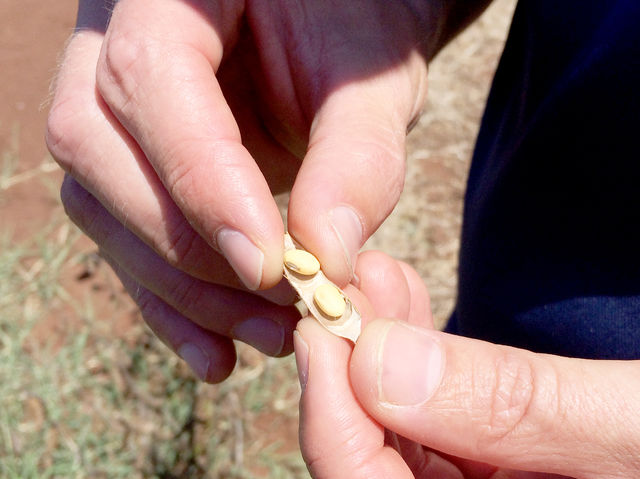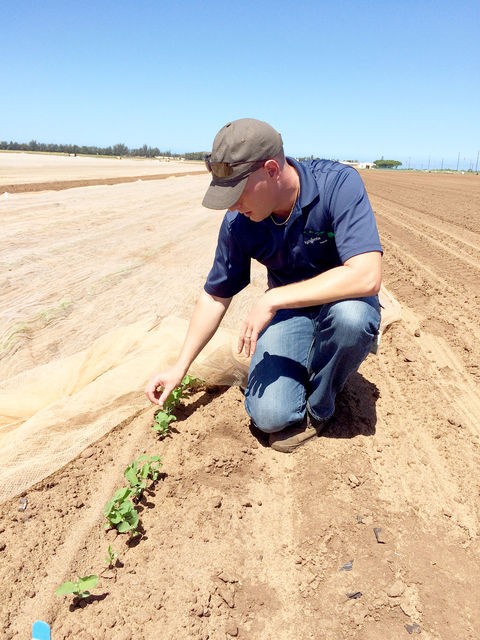KEKAHA — On a recent sun-drenched afternoon at Syngenta’s seed research facility, tidy rows of spring green leaves peered out of cracks in the earth. Blanketed over the eight-day-old soybean seedlings was an orange net, a layer of protection from
KEKAHA — On a recent sun-drenched afternoon at Syngenta’s seed research facility, tidy rows of spring green leaves peered out of cracks in the earth.
Blanketed over the eight-day-old soybean seedlings was an orange net, a layer of protection from the beaks of hungry birds.
Justin Robinson, a trial manager, momentarily pulled back the netting. Harmless white flies danced on the leaves.
“What we’re looking for is the plants that are going to give us the most desirable traits,” Robinson explained. “We’re also looking for problems, if there’s a seed that’s not doing what it’s supposed to do.”
Buried in Kekaha’s arid dirt are the engineered seeds of scientists who are searching for new ways to insert genes into plant DNA. The goal is to grow soybean and corn crops with desirable traits, such as resistance to rootworm or herbicide tolerance. The method, genetic modification, is as calculated as it is controversial.
“It’s so exact, it’s like changing a sentence,” said Mark Phillipson, Syngenta Hawaii’s spokesman. “‘The sky is gray.’ I can take out ‘gray’ and stick in ‘blue.’ I know it’s the fourth word in the sentence, and that changes everything.”
Hawaii — and Kauai in particular — is a research hub for genetically engineered crops that are sold to farmers worldwide. These biotech practices as well as the very existence of the companies that conduct them on the islands is a point of contention among some residents concerned about health and environmental safety.
Genetically engineered food is a subject of immense controversy. By manipulating plant DNA, scientists have learned to build crops resistant to insects, disease and drought, offering potential solutions to world hunger and a major boost to the food supply. Some GMO crops are engineered to withstand heightened amounts of herbicides and pesticides, which has made some people skeptical about whether they are safe.
While common in the U.S., GMO food crops are banned or strictly regulated in more than a dozen countries.
On Kauai, a joint fact-finding group tasked with looking into potential health and environmental impacts from pesticide use was formed in January. The $100,000 study, funded by the County of Kauai and the state Department of Agriculture, is geared as using available data to answer questions brewing in the community.
Officials for biotech seed companies like Syngenta have said their operations are not only safe, but integral to the state’s economy. Activists argue that the crops and the pesticides sprayed on them are hazardous.
In a move intended to ease the tension between the GMO food industry and activists aligned with the anti-GMO movement, Syngenta is revving up its public tour program. The company, which employs 110 workers on Kauai, has long offered an inside look at its fields and facilities, but only by request. Phillipson said the company will now begin to promote facility tours, a tool he said he hopes will squash “misconceptions.”
“One of the criticisms of our industry is that we’re not transparent,” Phillipson said. “I think part of the transparency is to invite the public to see what it is that we do. I think that once you see that there’s no skull and crossbones pesticides and there’s no hypodermic needle that we’re injecting the corn with, a lot of the misinformation kind of takes its own seat.”
Trial and error
Robinson, playing tour guide, waved a hand over a field of soybean seedlings. He pointed out groupings of eight 30-foot rows. All 1,600 or so plants in each grouping are the offspring of the same parent plant, he explained. Each seed is precisely sown and tracked by coordinates.
Robinson is charged with monitoring the health of the plants growing on a fraction of Syngenta’s 3,000 acres on Kauai. When he identifies plants that aren’t growing well, he calls in an agronomist, which is essentially a plant doctor who diagnoses the problem — disease, bugs, too much fertilizer — and devises a treatment plan. He’s also responsible for inputting the data derived from what’s happening in the fields into a computer information system.
Precision is essential to Syngenta’s operation. But determining which seeds will sprout plants that contain those desirable traits that farmers are looking for more closely resembles an Easter egg hunt than Christmas morning.
“There are a lot more losers than there are winners,” Phillipson said. “If we cross two varieties of corn, one parent that’s resistant to a certain insect and one parent that’s resilient to a fungus, a quarter of the seeds will turn out one way, half the seeds will turn out another way and there’s no way to know exactly what one is going to grow into what.”
In a grouping of 1,600 plants, only about 20 to 40 will contain the desired traits researchers are looking for, Robinson said.
To find those winners, researchers take holepunch-like tissue samples from each plants’ newest leaf. A lab analyzes the makeup of the tissue samples and processes the results, which help researchers identify the plants with the desirable traits that farmers want.
In the past, Syngenta scientists have genetically identified what it is in a plant that allows it to get the smallest morsel of water and still sprout.
“We want to make sure we give the farmers the best, highest potential seed we can possibly get so it’s going to have the highest yield,” Phillipson said. “We want all the characteristics that we’ve been looking for to be firing at 100 percent.”
Hawaii’s year-round grow season gives the process a boost.
“If this research was done on the Mainland, it would take 12, 13, 14 years to get there,” Phillipson said. “Here it takes about four years.”
The process may be relatively quick, but it’s not cheap. It costs up to $200 million to bring a new plant to the marketplace, Phillipson said.
“We do not do experimental pesticide research,” he added.
Much of the work is highly technical, which drives up the cost. But not all of it. To keep birds away from corn crops, Syngenta employs a rather rudimentary method: People with bells, clappers and other noisemakers. To be sure, the seed research process is full of juxtapositions.
When it comes to pesticides, Syngenta uses a prescriptive method. The facility does not conduct pesticide tolerance testing where a plant is sprayed in order to determine what amount of pesticides will cause the plant to die, Phillipson said.
“It’s reactionary,” Phillipson said. “If the plant is healthy and doing great and there are no pests on it, it doesn’t get sprayed at all. But some plants have a bug infestation that we just can’t seem to control for whatever reason. If we sprayed it two weeks ago but they’re back, happily feasting on the plant, then we’ll go and spray it again.”
On another field, across the highway from the soybean seedlings shrouded in orange netting, soybean plants stand hip-high. Nearly 100 days old, they are ready for harvest.
Robinson plucks a pod from the plant and opens it, revealing a pair of yellow seeds.
“In soy, we’re looking for seeds that are the correct size and dry or drying down, basically,” Robinson said.
After the seeds are dried out, they will either be delivered to a Syngenta facility on the Mainland for more research and development — or for mass production.
“That’s where the farmer gets it,” Robinson said. “From the time they start working with them to the time the farmer gets them, these seeds travel all over the Mainland, and sometimes South America and Europe before the farmer ever gets it.”
•••
Brittany Lyte, environmental reporter, can be reached at 245-0441.



